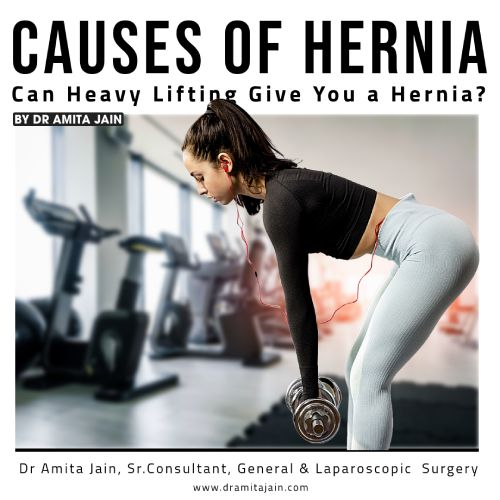A hernia occurs when organs or tissues protrude through weakened spots in surrounding muscle or connective tissue. This weakening or tearing of tissue allows intestines to push through muscles, creating a noticeable lump beneath the skin. If the muscles don’t close behind the protruding organ, it can lead to a dangerous condition called a strangulated hernia. The type of hernia depends on the location of the weakness, with inguinal, umbilical, femoral, and incisional hernias being common variants.
While it’s commonly thought that heavy weightlifting causes hernias, Dr Amita Jain, one of the leading laparoscopic surgeons in Delhi who specialises in hernia surgery, highlights this connection’s complexity in this blog. Research indicates that regular heavy weightlifting can increase pressure on abdominal muscles and nearby tissues, potentially exacerbating pre-existing weaknesses and leading to hernia development. However, it’s important to note that heavy lifting doesn’t directly cause hernias but can trigger them in individuals with specific predispositions such as a weakened abdominal wall, prior hernias, or surgical sites that haven’t fully healed.
What are the causes of Hernia?
Several factors contribute to the development of hernias beyond just heavy lifting. Age can weaken muscles, increasing hernia risk. Genetics may make some people more prone to muscle weakness in the abdomen. Smoking can lead to a chronic cough, and straining abdominal muscles. Multiple pregnancies or having COPD (Chronic Obstructive Pulmonary Disease) can also strain the abdomen. Weak abdominal muscles are key to hernia development. They create vulnerability to various factors, whether from birth or external stressors like intense physical activity. A strong abdominal wall is vital to prevent hernias.
How does lifting heavy weights cause a hernia?
When you lift heavy weights, the pressure within your abdomen naturally increases, serving to stabilize your spine and organs. This heightened pressure, compounded by repeated lifting, can strain the abdominal wall over time, potentially leading to weakened or torn tissue and the emergence of hernias. The increased intra-abdominal pressure (IAP) from lifting heavy objects gradually weakens the myofascial tissues, making them more susceptible to herniation.
Factors such as the way weight is lifted, inherent weakness in the abdominal wall near areas like the belly button or groin, and genetic predispositions can further exacerbate the risk. While some individuals may lift heavy weights without developing hernias, the cumulative effect of high IAP and predisposing factors can increase the likelihood of hernia occurrence, emphasizing the importance of considering both activity-related stress and genetic influences in hernia development.
So, does that mean that you can never prevent hernias while exercising or lifting heavy weights? Not exactly, but there are precautions you can take:
- Warm up properly: Though warming up may not directly prevent hernias, it’s still crucial. It raises your heart rate, increases body temperature, and improves circulation, making muscles more flexible and less prone to injury.
- Know your limits and focus on form: Avoid overexertion by selecting weights that allow you to comfortably complete sets of 10 to 15 reps. Straining too hard increases the risk of poor form, which can lead to various injuries, including hernias.
- Listen to your body: While pushing yourself is part of the exercise, severe pain is a sign to stop. It’s okay to feel discomfort, but if an activity causes intense pain, it’s crucial to cease immediately to prevent injury.
While it is true that hernias do not heal on their own, not all require immediate repair. Some may become trapped in the muscular wall, requiring urgent attention, but many can be monitored for deterioration. Treatment is necessary if they cause discomfort, or severe pain, interfere with daily activities, or lead to more serious conditions like bowel obstruction.
Therefore, while heavy weightlifting doesn’t directly cause hernias, it can worsen pre-existing weaknesses. Understanding risk factors, practising proper form, and listening to your body are key to mitigating the risk, emphasizing the importance of balanced exercise and caution.

Dr Amita Jain is one of India’s most distinguished and experienced female surgeons, known for her unmatched expertise in general and laparoscopic surgery. With over 29 years of surgical excellence, Dr Amita Jain has built a reputation for precision, compassionate care, and advanced surgical techniques.
Dr Amita Jain has successfully performed a wide range of complex general surgeries, including both open and minimally invasive procedures, with a strong focus on trauma care, onco-surgical techniques, and reconstructive surgeries. Her areas of specialisation include (including Gallbladder stone removal, appendix removal, hernia repair surgery, piles and fissure surgeries). She was the Professor of Surgery at the Army College of Medical Sciences and Base Hospital, Delhi Cantt. In 1994, she was commissioned asa Surgeon under the United Nations Mission in Congo. From 2020 to 2022, she worked with Bansals Hospital. Currently, Dr Amita Jain is the Senior General and Laparoscopic Surgeon at Rainbow Children Hospitals (Malviya Nagar, Delhi), Artemis Lite: Multi-Speciality Care Hospital (New Friends Colony, New Delhi) and at Rosewalk – Luxury Maternity Hospital in Delhi (Panchsheel Park, Delhi)
Call Us at +(91) 882-6615301
